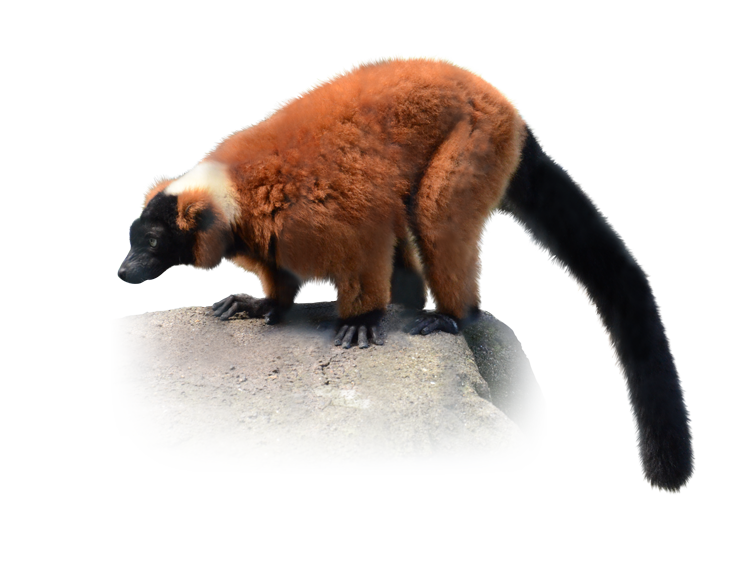
Varecia rubra (É. Geoffroy, 1812)
子育てを巣で行うサル
Monkeys Raising Their Babies in a Nest
体長50 – 56cm、尾長56 – 65cm。体重3.5 – 4.5kg。身体より長い尻尾は黒い毛で覆われており、熱帯雨林の樹冠を移動する際にバランスを保つのに役立ちます。全身は明るい茶色の毛で覆われており、顔は黒色で襟首が白いのが特徴です。密集した毛は湿潤な熱帯雨林の環境下でも乾燥した状態を保つのに役立ちます。
キツネザルの中で最大の本種は果食性が特に高く、果実・花の蜜を好んで食べることで、種子散布者としてまた花粉媒介者としてマダガスカルの森において重要な役目を果たします。繁殖期は5月から7月、妊娠期間102日を経て、9月から10月にかけて一度に2 – 6匹の子を産みます。生まれた子は高さ10m以上にもなる樹の上に作られた巣の中で育てるのですが、母親は餌を採るために赤ちゃんを置いたまま外出することもあります。生後1 – 2週間すると一緒に移動するようになるのですが、母親が外出中に赤ちゃんが巣から誤って落下することも多く、生後3カ月の生存確率は約35%です。
姿形が似ていますが体色が白黒であるクロシロエリマキキツネザルはかつて本種の亜種とされていましたが、2001年に新種として独立しました。これらの2種でエリマキキツネザル属を形成します。どちらも生息地の喪失と狩猟により生息数を減らしており、特に生息域が非常に限られているアカエリマキキツネザルはIUCNの評価において近絶滅種(CR)に分類されています。
It measures 50-56cm in body length and 56-65cm in tail length. It weighs 3.5-4.5kg. Its long tail, covered in black fur, helps it maintain balance while moving through the rainforest canopy. Its entire body is covered in light brown fur, with a distinctive black face and white nape. Its dense fur helps it stay dry even in the humid rainforest environment.
This species, the largest of all lemurs, is particularly frugivorous, preferring fruit and nectar, and plays an important role in the forests of Madagascar as a seed disperser and pollinator. It breeds from May to July, and after a 102-day gestation period, gives birth to 2-6 babies at a time between September and October. The babies are raised in nests built high in trees, sometimes reaching heights of over 10m, although the mother may leave them unattended while foraging. They begin to travel together when they are 1-2 weeks old, but babies often accidentally fall out of the nest while their mother is out, and the survival rate at 3 months of age is approximately 35%.
The black-and-white ruffed lemur, which looks similar but is black and white, was once considered a subspecies of this species, but was separated into a new species in 2001. These two species make up the genus Lemur. Both species have seen their populations decline due to habitat loss and hunting, and the red ruffed lemur, in particular, whose range is extremely limited, has been classified as Critically Endangered (CR) by the IUCN.
参考文献
“Red Ruffed Lemur” Duke Lemur Center. 2025年9月7日閲覧
“Varecia variegata (Lemur variegatus)” Animal Info. 2025年9月7日閲覧
井上 紗奈「エリマキキツネザルにおける生息環境と色知覚の関係についての考察」, 霊長類研究 Supplement, 2017, 33 巻, 第33回日本霊長類学会大会, セッションID P04, p. 54. 2025年9月7日閲覧